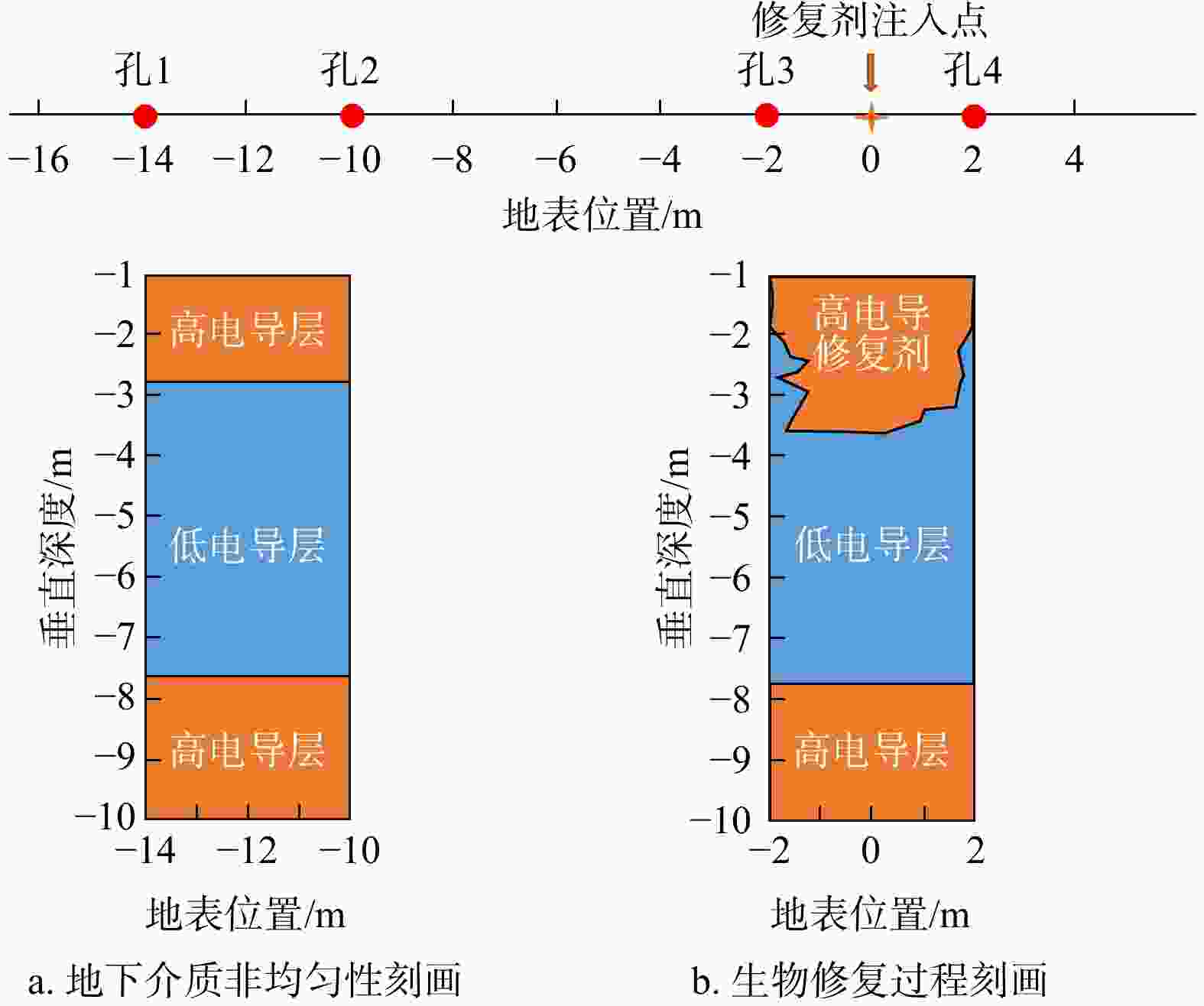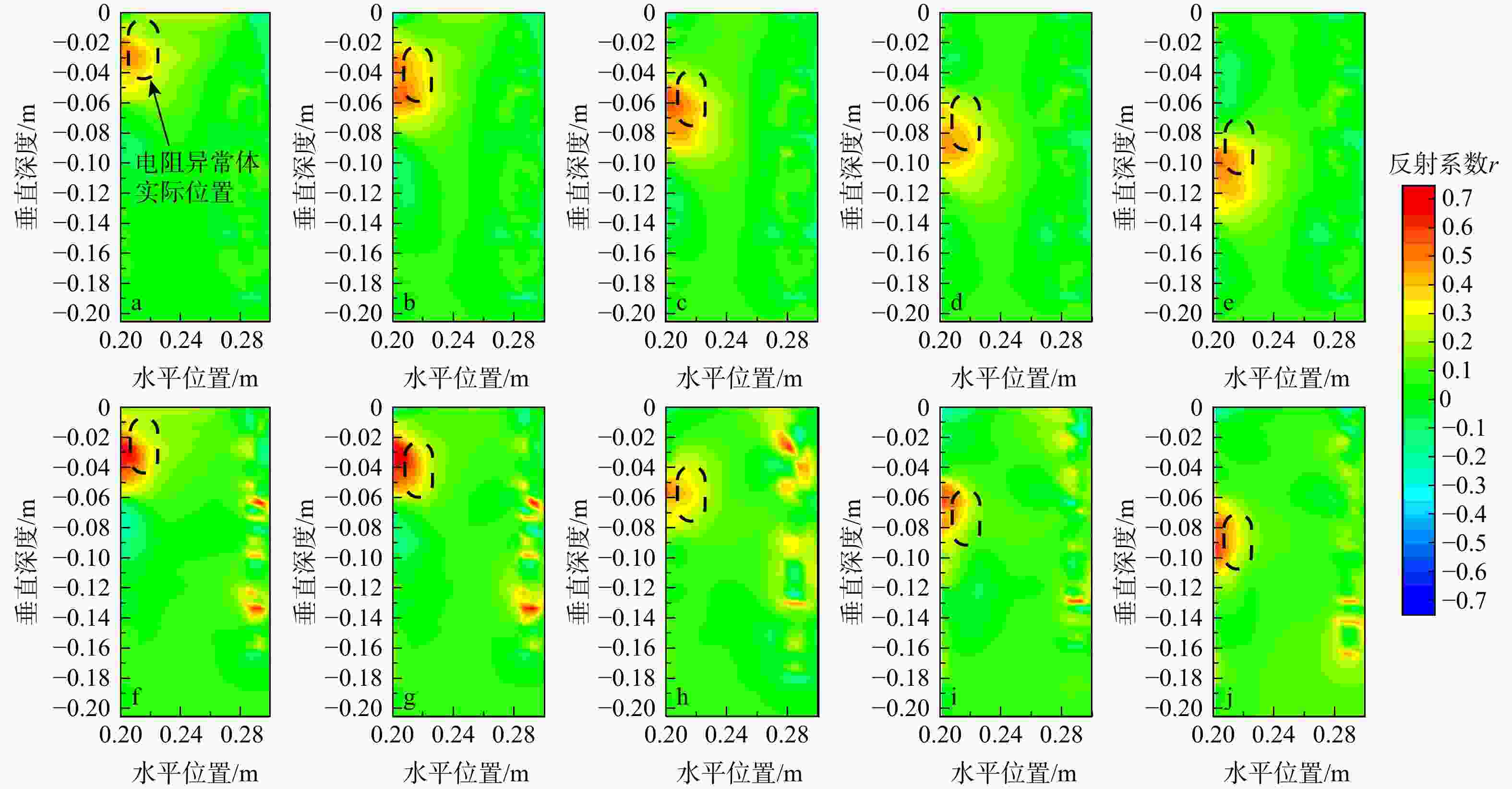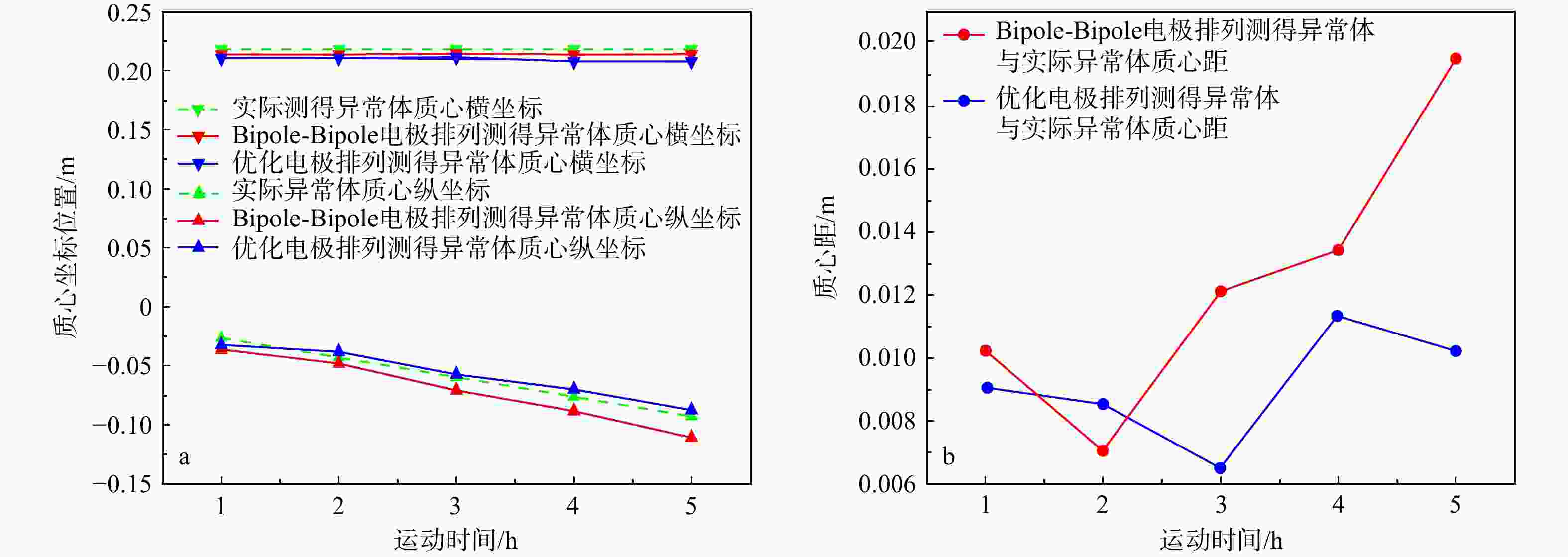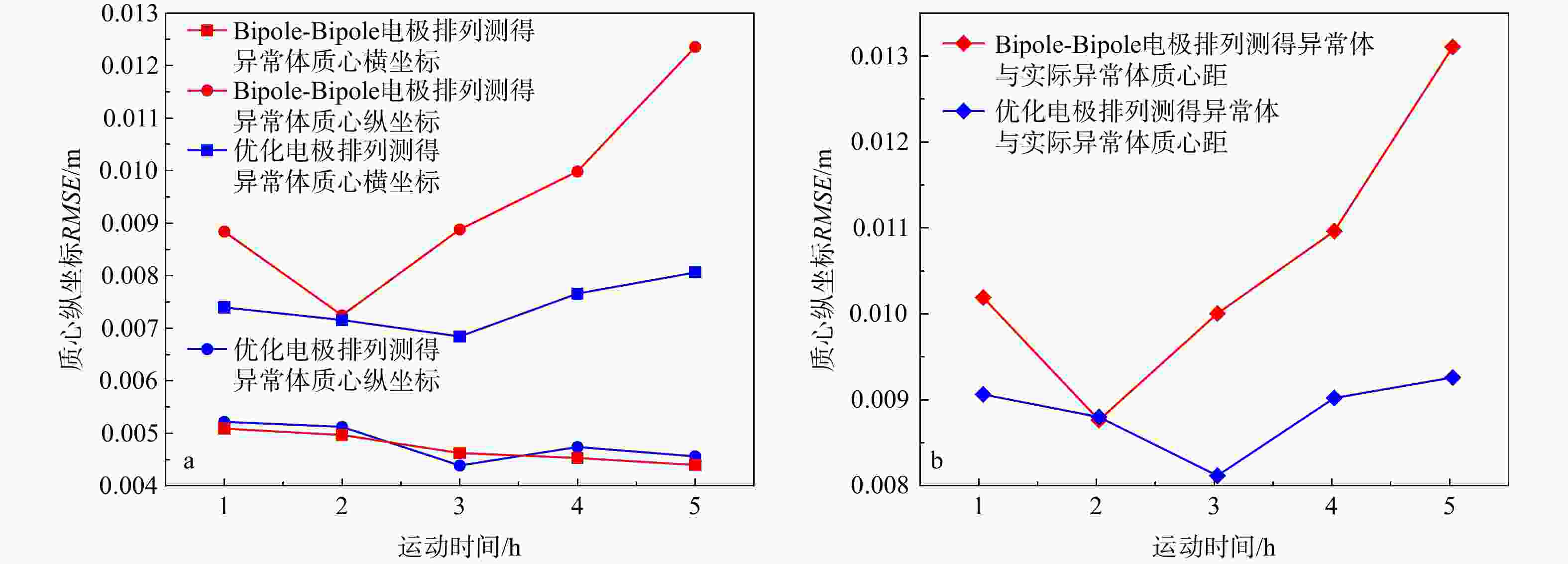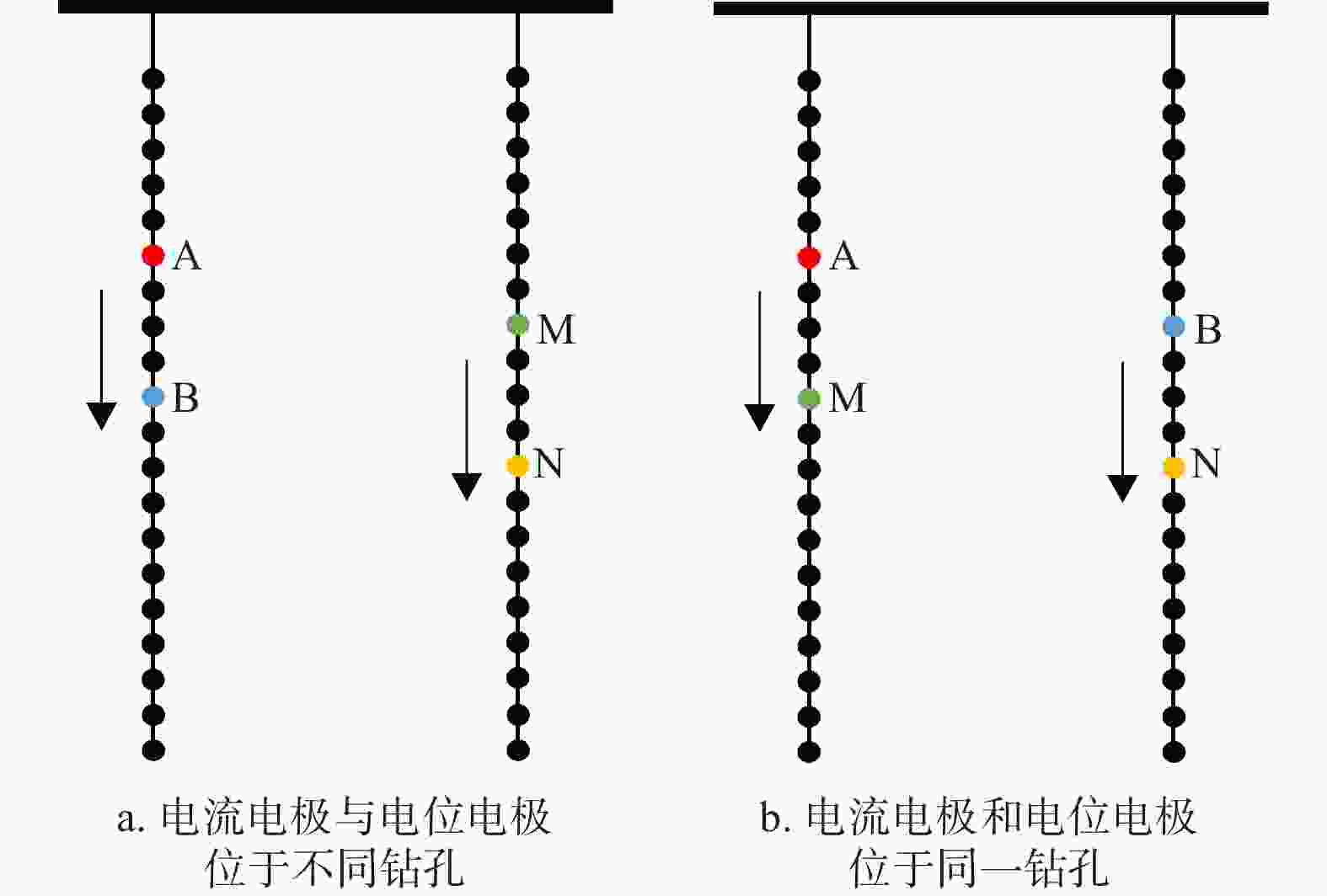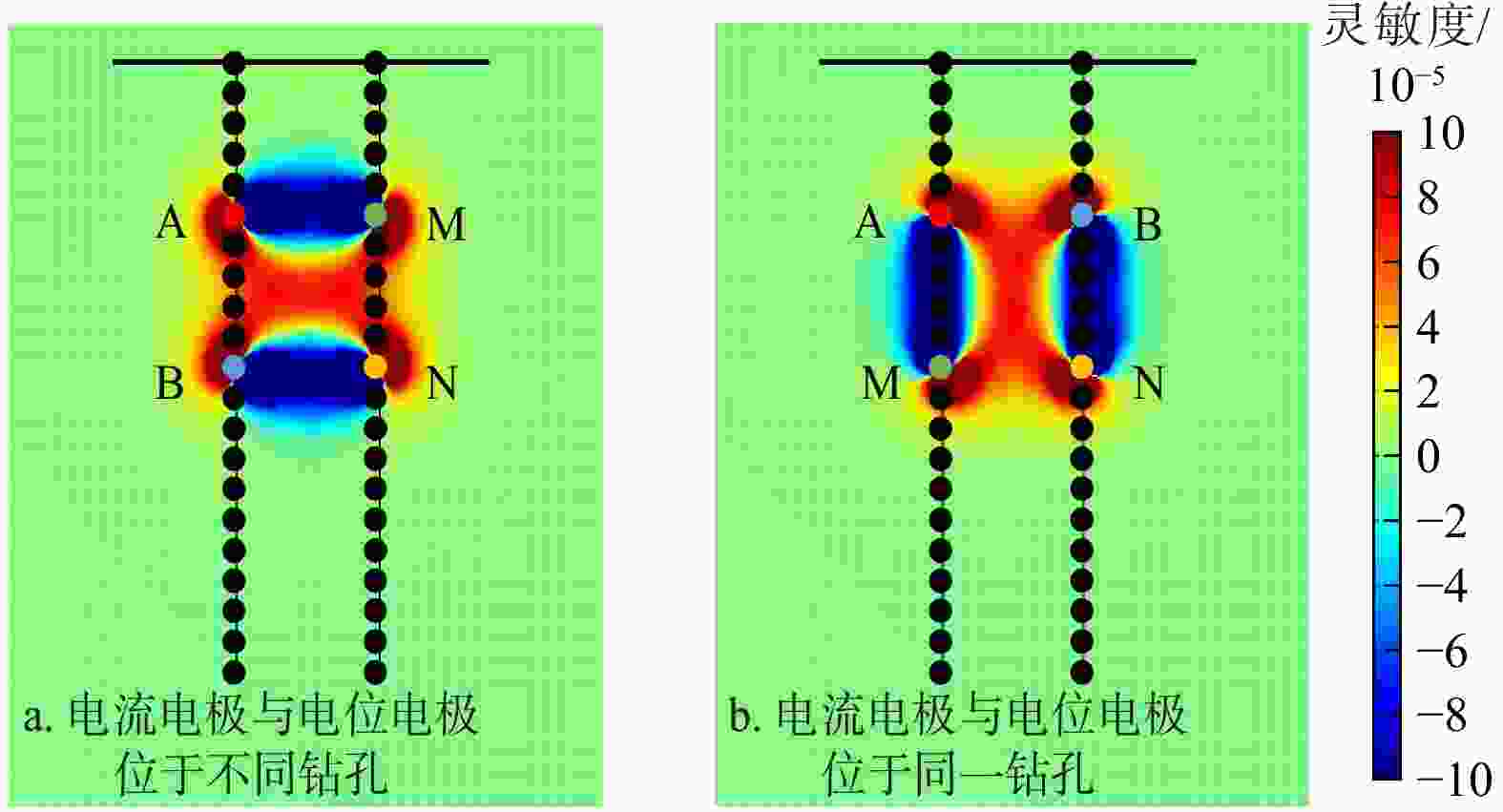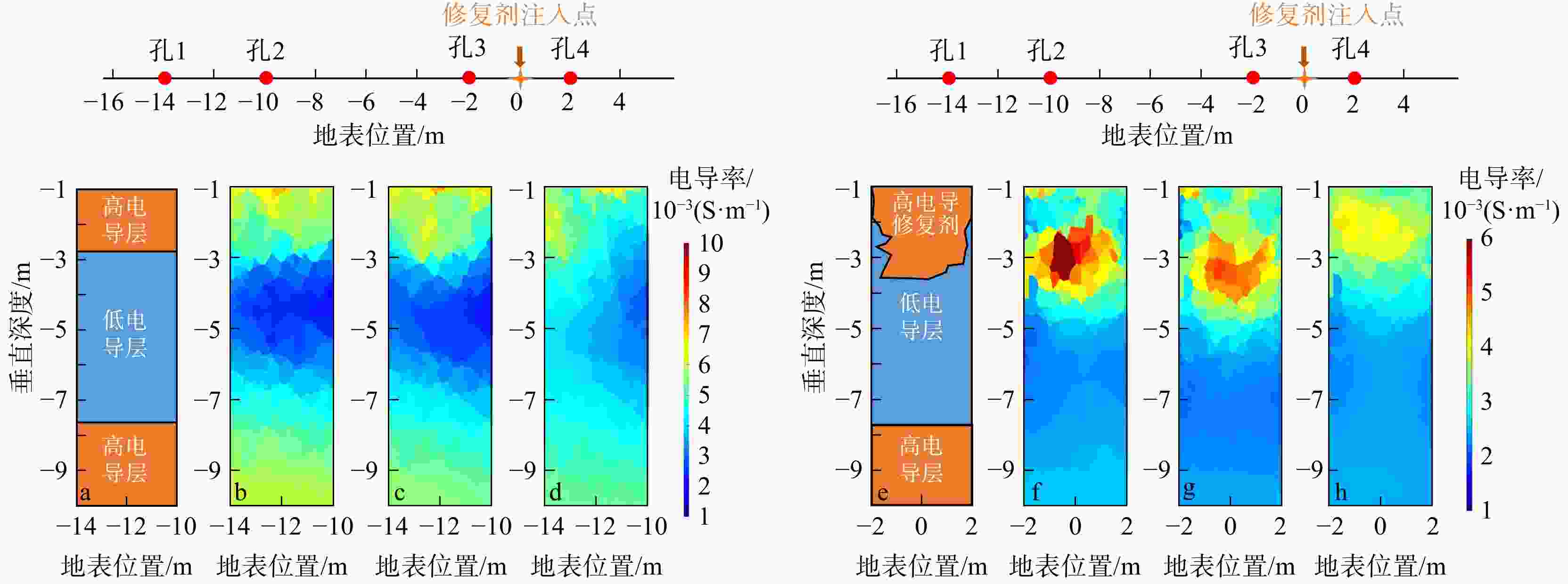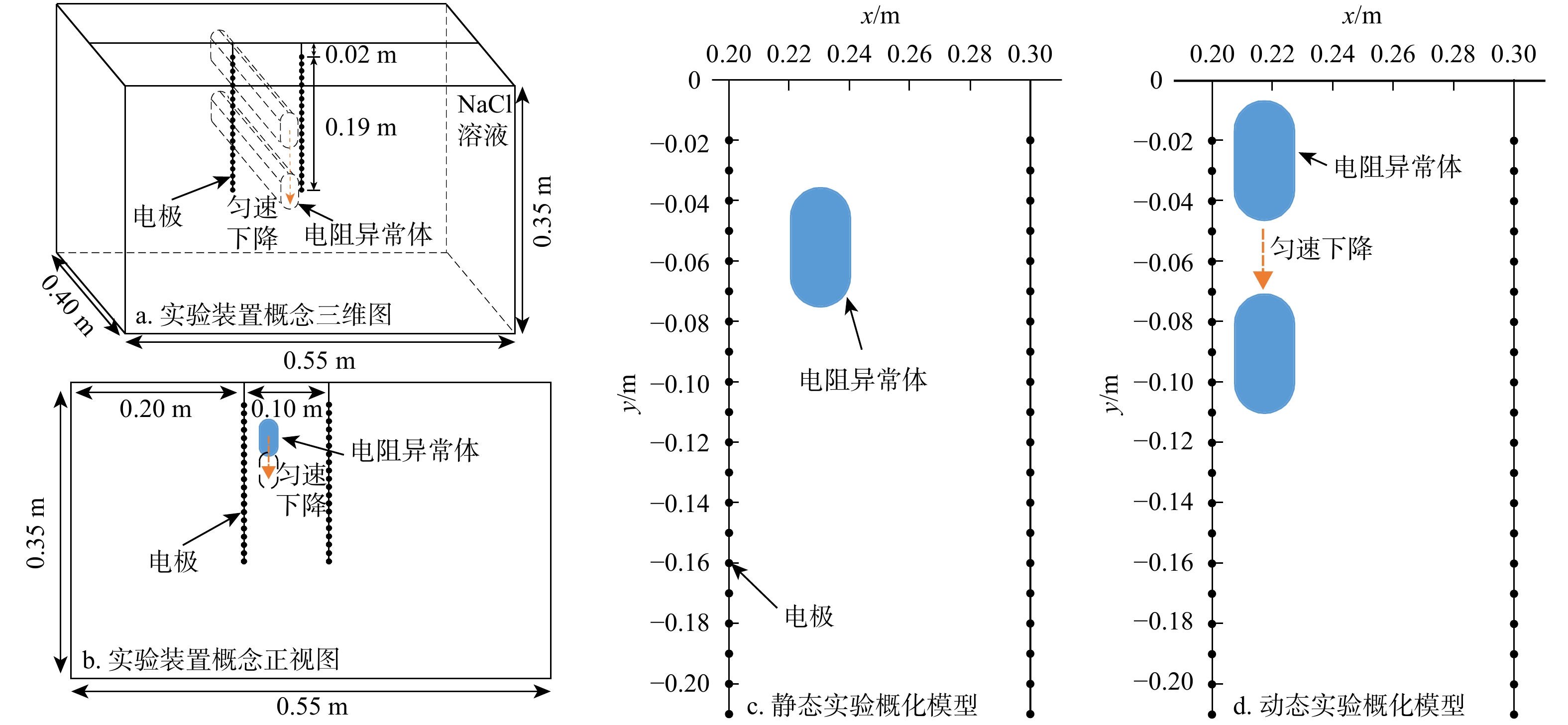Optimizing 4D hydrogeological process monitoring using cross-hole electrical resistivity tomography (CHERT) via Bayesian experimental design
-
摘要:
地球物理方法可以有效监测四维水文地质过程中水流的动态和物质的传输,其成像精度往往与监测布置方案密切相关。以常用的高密度电阻率法(electrical resistivity tomography,简称ERT)为例,为了获得良好的成像精度往往需要大量的电极排列,导致监测时间较长,因而不能实时响应四维水文地质动态过程。已有ERT监测方案优化研究多侧重地表ERT,很少针对跨孔ERT。由于跨孔ERT在研究区域高精度刻画方面更具优势,提出了采用贝叶斯实验设计优化跨孔ERT监测方案。通过室内静态/动态实验以及野外场地数据,对比优化电极排列与传统电极排列的监测时间与监测精度,验证了贝叶斯实验设计优化方案的有效性。室内实验结果表明:优化后监测方案能减少约75%的监测时间,而且优化方案反演结果能更精准地动态刻画电阻异常区域,显著改善传统方案监测四维水文地质过程的滞后性误差。野外场地实验验证表明:在保证监测精度的前提下优化方案可减少约95%的监测时间。基于贝叶斯实验设计优化跨孔ERT电极排列监测方案为四维水文地质过程的高效监测提供了技术支撑。
Abstract:Objective Geophysical methods can effectively monitor the dynamics of water flow and material transport in 4D hydrogeological processes, and its imaging accuracy is often closely related to the monitoring scheme. Taking the commonly used electrical resistivity tomography (ERT) as an example, obtaining good imaging accuracy often requires a large number of electrode arrays, leading to a long data acquisition time and inability to respond in a timely manner to 4D hydrogeological dynamics. Previous optimization studies of ERT monitoring schemes have mainly focused on surface ERT, whereas cross-hole ERT (CHERT) has received far less attention.
Methods Due to the advantages of CHERT in high-precision characterization, this study proposes using Bayesian experimental design to optimize CHERT monitoring scheme. Through laboratory static and dynamic tests and a field application, data acquisition time and imaging accuracy between the optimized and traditional electrode configurations to evaluate the effectiveness of the Bayesian-based optimization.
Results Laboratory tests demonstrate that the optimized monitoring scheme can reduce acquisition time by approximately 75%, and the inversion results more accurately delineate the evolving resistivity anomaly zones, thereby mitigating the lag effect observed in traditional schemes. The field application shows that the optimized scheme can reduce monitoring time by approximately 95%.
Conclusion The optimization of CHERT electrode configurations based on Bayesian experimental design provides a technical basis for efficient monitoring of 4D hydrogeological processes.
-
图 6 不同电极排列测得异常体质心坐标 (a) 及其与实际异常体质心距 (b) 的均方根误差(RMSE)
Figure 6. Root-mean-square errors of centroid coordinates of the anomaly measured by different electrode configurations (a) and root-mean-square errors of centroid distances between the anomaly measured by different electrode configurations and the actual anomaly (b)
-
[1] HERMANS T, GODERNIAUX P, JOUGNOT D, et al. Advancing measurements and representations of subsurface heterogeneity and dynamic processes: Towards 4D hydrogeology[J]. Hydrology and Earth System Sciences, 2023, 27(1): 255-287. doi: 10.5194/hess-27-255-2023 [2] ROBERT T, PAULUS C, BOLLY P Y, et al. Heat as a proxy to image dynamic processes with 4D electrical resistivity tomography[J]. Geosciences, 2019, 9(10): 414. doi: 10.3390/geosciences9100414 [3] 焦如义. 高密度电法在水平定向钻穿越孔壁稳定性检测中的应用[J]. 地质科技情报, 2016, 35(2): 108-112.JIAO R Y. Feasibility study on borehole collapse detection of HDD by high density electrical method[J]. Geological Science and Technology Information, 2016, 35(2): 108-112. (in Chinese with English abstract [4] JOHNSON T C, HAMMOND G E, CHEN X Y. PFLOTRAN-E4D: A parallel open source PFLOTRAN module for simulating time-lapse electrical resistivity data[J]. Computers & Geosciences, 2017, 99: 72-80. [5] 高畅, 邢程, 郭秀军, 等. 不同演化阶段的NAPLs污染区高密度电阻率法探测效果分析[J]. 中国海洋大学学报(自然科学版), 2020, 50(增刊1): 128-136.GAO C, XING C, GUO X J, et al. Effect analysis of electrical resistivity tomography (ERT) detection in NAPLs contaminated areas at different evolutionary stages[J]. Periodical of Ocean University of China, 2020, 50(S1): 128-136. (in Chinese with English abstract [6] DIMECH A, CHENG L Z, CHOUTEAU M, et al. A review on applications of time-lapse electrical resistivity tomography over the last 30 years: Perspectives for mining waste monitoring[J]. Surveys in Geophysics, 2022, 43(6): 1699-1759. doi: 10.1007/s10712-022-09731-2 [7] 苏永军, 范翠松, 赵更新, 等. 综合电法在探测海水入侵界面中的研究与应用: 以莱州湾地区为例[J]. 物探与化探, 2020, 44(3): 704-708.SU Y J, FAN C S, ZHAO G X, et al. Research and application of comprehensive electrical method in detecting saltwater intrusion interface: A case study of Laizhou Bay area[J]. Geophysical and Geochemical Exploration, 2020, 44(3): 704-708. (in Chinese with English abstract [8] ASARE A, APPIAH-ADJEI E K, OWUSU-NIMO F, et al. Lateral and vertical mapping of salinity along the coast of Ghana using electrical resistivity tomography: The case of Central Region[J]. Results in Geophysical Sciences, 2022, 12: 100048. doi: 10.1016/j.ringps.2022.100048 [9] 李继兴, 严松, 杨春健, 等. 泥质砂岩残积土边坡降雨冲刷特性[J]. 地质科技通报, 2022, 41(2): 26-33.LI J X, YAN S, YANG C J, et al. Rainfall erosion characteristics of argillaceous sandstone residual soil slopes[J]. Bulletin of Geological Science and Technology, 2022, 41(2): 26-33. (in Chinese with English abstract [10] WILKINSON P, CHAMBERS J, UHLEMANN S, et al. Reconstruction of landslide movements by inversion of 4D electrical resistivity tomography monitoring data[J]. Geophysical Research Letters, 2016, 43(3): 1166-1174. doi: 10.1002/2015GL067494 [11] TORRESE P. Investigating karst aquifers: Using pseudo 3D electrical resistivity tomography to identify major karst features[J]. Journal of Hydrology, 2020, 580: 124257. doi: 10.1016/j.jhydrol.2019.124257 [12] 刘金涛, 胡晓明. 高密度电法勘探在岩溶查找中的应用[J]. 地质科技情报, 2003, 22(2): 100-102.LIU J T, HU X M. Application of the distributed multi-electrode resistivity imaging method in finding the karst[J]. Geological Science and Technology Information, 2003, 22(2): 100-102. (in Chinese with English abstract [13] 郭蕾蕾, 魏良帅, 黄安邦, 等. 乌蒙山地区岩溶地下水流系统结构及其找水应用[J]. 地质科技通报, 2022, 41(1): 146-157.GUO L L, WEI L S, HUANG A B, et al. Structure of karst groundwater system and its water exploration in Wumeng Mountain area[J]. Bulletin of Geological Science and Technology, 2022, 41(1): 146-157. (in Chinese with English abstract [14] 潘剑伟, 占嘉诚, 洪涛, 等. 地面核磁共振方法和高密度电阻率法联合找水[J]. 地质科技情报, 2018, 37(3): 253-262.PAN J W, ZHAN J C, HONG T, et al. Combined use of surface nuclear magnetic resonance and electrical resistivity imaging in detecting groundwater[J]. Geological Science and Technology Information, 2018, 37(3): 253-262. (in Chinese with English abstract [15] ABDULLAH F M, LOKE M H, NAWAWI M, et al. Assessing the reliability and performance of optimized and conventional resistivity arrays for shallow subsurface investigations[J]. Journal of Applied Geophysics, 2018, 155: 237-245. doi: 10.1016/j.jappgeo.2018.06.018 [16] BELLMUNT F, MARCUELLO A, LEDO J, et al. Capability of cross-hole electrical configurations for monitoring rapid plume migration experiments[J]. Journal of Applied Geophysics, 2016, 124: 73-82. doi: 10.1016/j.jappgeo.2015.11.010 [17] SINGHA K, GORELICK S M. Saline tracer visualized with three-dimensional electrical resistivity tomography: Field-scale spatial moment analysis[J]. Water Resources Research, 2005, 41(5); W05023. [18] FURMAN A, FERRÉ T P A, WARRICK A W. Optimization of ERT surveys for monitoring transient hydrological events using perturbation sensitivity and genetic algorithms[J]. Vadose Zone Journal, 2004, 3(4): 1230-1239. doi: 10.2136/vzj2004.1230 [19] STUMMER P, MAURER H, GREEN A G. Experimental design: Electrical resistivity data sets that provide optimum subsurface information[J]. Geophysics, 2004, 69(1): 120-139. doi: 10.1190/1.1649381 [20] WILKINSON P B, LOKE M H, MELDRUM P I, et al. Practical aspects of applied optimized survey design for electrical resistivity tomography[J]. Geophysical Journal International, 2012, 189(1): 428-440. doi: 10.1111/j.1365-246X.2012.05372.x [21] LOKE M H, WILKINSON P B, CHAMBERS J E, et al. Optimized arrays for 2D resistivity survey lines with a large number of electrodes[J]. Journal of Applied Geophysics, 2015, 112: 136-146. doi: 10.1016/j.jappgeo.2014.11.011 [22] QIANG S Y, SHI X Q, KANG X Y, et al. Optimized arrays for electrical resistivity tomography survey using Bayesian experimental design[J]. Geophysics, 2022, 87(4): 189-203. doi: 10.1190/geo2021-0408.1 [23] WANG H R, LIN C P, LIU H C. Pitfalls and refinement of 2D cross-hole electrical resistivity tomography[J]. Journal of Applied Geophysics, 2020, 181: 104143. doi: 10.1016/j.jappgeo.2020.104143 [24] 柴伦炜. 井间超高密度电法探测基桩的模拟及应用[J]. 物探与化探, 2022, 46(5): 1283-1288.CHAI L W. A simulation and application of cross-well ultra-high-density resistivity imaging in the detection of foundation piles[J]. Geophysical and Geochemical Exploration, 2022, 46(5): 1283-1288. (in Chinese with English abstract [25] WANG T P, CHEN Y T, CHEN C C, et al. Application of cross-hole electrical resistivity tomography to groundwater contaminated remediation site[J]. Terrestrial, Atmospheric and Oceanic Sciences, 2020, 31(5): 507-521. doi: 10.3319/TAO.2019.06.17.01 [26] LEONTARAKIS K, APOSTOLOPOULOS G V. Laboratory study of the cross-hole resistivity tomography: The Model Stacking (MOST) technique[J]. Journal of Applied Geophysics, 2012, 80: 67-82. doi: 10.1016/j.jappgeo.2012.01.005 [27] GOES B J M, MEEKES J A C. An effective electrode configuration for the detection of DNAPLs with electrical resistivity tomography[J]. Journal of Environmental and Engineering Geophysics, 2004, 9(3): 127-141. doi: 10.4133/JEEG9.3.127 [28] BING Z, GREENHALGH S A. Cross-hole resistivity tomography using different electrode configurations[J]. Geophysical Prospecting, 2000, 48(5): 887-912. doi: 10.1046/j.1365-2478.2000.00220.x [29] LINDLEY D V. On a measure of the information provided by an experiment[J]. The Annals of Mathematical Statistics, 1956, 27(4): 986-1005. doi: 10.1214/aoms/1177728069 [30] HUAN X, MARZOUK Y M. Simulation-based optimal Bayesian experimental design for nonlinear systems[J]. Journal of Computational Physics, 2013, 232(1): 288-317. doi: 10.1016/j.jcp.2012.08.013 [31] WILKINSON P B, UHLEMANN S, MELDRUM P I, et al. Adaptive time-lapse optimized survey design for electrical resistivity tomography monitoring[J]. Geophysical Journal International, 2015, 203(1): 755-766. doi: 10.1093/gji/ggv329 [32] KESSOURI P, JOHNSON T, DAY-LEWIS F D, et al. Post-remediation geophysical assessment: Investigating long-term electrical geophysical signatures resulting from bioremediation at a chlorinated solvent contaminated site[J]. Journal of Environmental Management, 2022, 302: 113944. doi: 10.1016/j.jenvman.2021.113944 [33] JOHNSON T C, VERSTEEG R J, DAY-LEWIS F D, et al. Time-lapse electrical geophysical monitoring of amendment-based biostimulation[J]. Groundwater, 2015, 53(6): 920-932. doi: 10.1111/gwat.12291 -




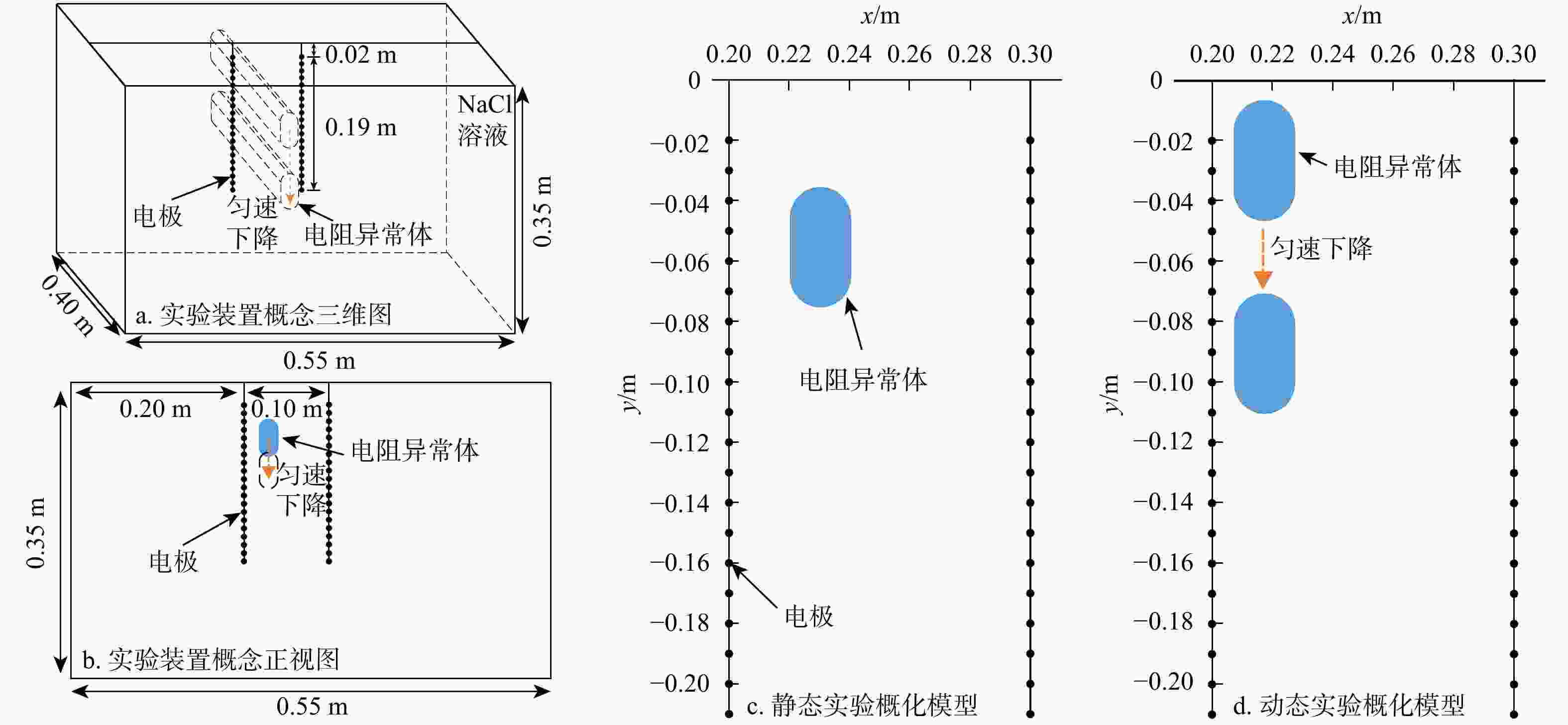
 下载:
下载:
